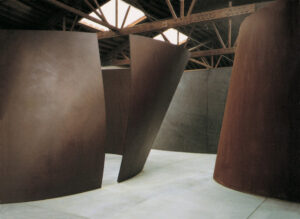Image: Richard Serra, Tilted Arc, installed 1981
Few may remember Tilted Arc, the hulking steel slab by American sculptor Richard Serra that once stood on Foley Federal Plaza in downtown New York City. Unveiled in 1981 and measuring 120 feet long and 12 feet high, Tilted Arc as a monumental work of site-specific urban art seemed bereft of any whimsey, charm or light-heartedness—unlike, say, a bright red stabile by Alexander Calder or a giant prancing rabbit by Barry Flanagan. Indeed, Tilted Arc loomed so menacingly over the plaza that rush hour workers streaming to the nearby courthouses each day felt threatened by it, and, worse, complained that weaving around it made their daily commute longer. Petitions began appearing for its removal.
And while the art world weighed in on the controversy with sympathy for the artist, others were more scathing and dismissive. “To the misery of working in an ugly and poorly designed building,” said the eminent sociologist Nathan Glazer, “it was Serra’s thought to add additional misery in the form of a sculpture that was ugly to most people… that obstructed the plaza, that offered no space to sit on, that blocked sun and view, and made the plaza unusable even for those moments of freedom when the weather permitted office workers to eat their lunch outside.”
And so, amidst many public hearings, howls of protests from all sides, and a $30 million lawsuit by Serra to prevent the United States General Services Administration from removing a sculpture they had commissioned and paid for, a ruling was finally made. Tilted Arc would be dismantled and trucked away to storage. There it remains, likely never to be seen again.
This was hardly a setback for Richard Serra’s career as an artist. Indeed, in the 1980s he was only just getting started as a fabricator of industrial steel on a mammoth scale. Perhaps the rejection of Tilted Arc only emboldened him to think even bigger and more menacingly. And if the so-called “public” failed to appreciate his work, or to understand his occasionally mystifying descriptions of it, there were plenty of mega-rich private collectors, museums and foundations throughout the world eager to commission a site-specific piece from Serra, and the bigger the better.
Today one can hardly name a major museum that has not exhibited or acquired sculpture by Richard Serra, whose mammoth COR-TEN steel ellipses, spirals and arcs seem, in a curiously cold and thrilling way, to overwhelm all else in a museum setting. On the other hand, Serra’s landscape pieces in pastoral settings seem softer and more benign. Take, for example, Te Tuhirangi Contour, a 20-foot-high slab of steel stretching 844 feet across rolling farmland in New Zealand. But Serra has always made his biggest and most jarring impact with museum exhibitions, where whole rooms can be dwarfed by his sculptures.

One experiences this at DIA Beacon, a private museum in upstate New York created within a gargantuan former Nabisco box-printing factory built in 1929. The soaring, light-filled spaces of the museum are perfect for the large-scale paintings and sculpture one finds in its cavernous rooms. But only Serra can swallow one of these rooms whole. To see what I mean just wander down to the basement and you’ll find Torqued Ellipses II, a Serra sculpture of 1997-1998 (pictured).
It’s an almost surreal experience. For despite its oppressive size, Torqued Ellipses II teasingly dares you to be bold and step inside, through a slit-like opening, and feel the haunting, spine-tingling silence within. It’s a curiously calming sensation.
Maybe that’s what was missing with Tilted Arc, which in the 1980s so many found ugly and soul-crushing. The artist had not yet learned how to attract, rather than repel, his public.
It’s a magic trick every great artist eventually learns.

